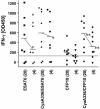Recognition of mycobacterial antigens delivered by genetically detoxified Bordetella pertussis adenylate cyclase by T cells from cattle with bovine tuberculosis
- PMID: 15501751
- PMCID: PMC523049
- DOI: 10.1128/IAI.72.11.6255-6261.2004
Recognition of mycobacterial antigens delivered by genetically detoxified Bordetella pertussis adenylate cyclase by T cells from cattle with bovine tuberculosis
Abstract
The exponential increase in the incidence of tuberculosis in cattle over the last two decades in the British national herd constitutes a significant economic problem. Therefore, research efforts are under way to develop cattle tuberculosis vaccines and specific diagnostic reagents to allow the distinction of vaccinated from infected animals. Mycobacterial antigens like ESAT-6 and CFP10 allow this distinction. This study investigates whether fusion protein of ESAT-6 or CFP10 with genetically detoxified Bordetella pertussis adenylate cyclase (CyaA) are recognized by Mycobacterium bovis-infected cattle more effectively than conventional recombinant proteins are, thus enhancing sensitivity or reducing the amount of antigens required. By measuring the frequencies of gamma interferon (IFN-gamma)-producing cells, we were able to show that the presentation of CFP10 as a CyaA fusion protein enhanced the molecular efficiency of its recognition 20-fold, while the recognition of ESAT-6 was not improved by CyaA delivery. Furthermore, in the whole-blood IFN-gamma test currently used in the field, the delivery of CFP10 and ESAT-6 by fusion to CyaA increased the amount of IFN-gamma produced and hence the proportion of infected animals responding to CFP10. The improved T-cell recognition of CyaA336/CFP10 was found to be dependent upon interaction with CD11b. In addition, presentation of CyaA336/CFP10 to CD4+ T cells was chloroquine sensitive, and CFP10 delivery by CyaA resulted in its accelerated presentation to T cells. In conclusion, the use of CyaA fusion proteins with ESAT-6 and CFP10 has the potential to improve the sensitivity of immunodiagnostic tests detecting bovine tuberculosis in cattle.
Figures





Similar articles
-
Efficient Ex vivo stimulation of Mycobacterium tuberculosis-specific T cells by genetically detoxified Bordetella pertussis adenylate cyclase antigen toxoids.Infect Immun. 2005 May;73(5):2991-8. doi: 10.1128/IAI.73.5.2991-2998.2005. Infect Immun. 2005. PMID: 15845506 Free PMC article. Clinical Trial.
-
An increase in antimycobacterial Th1-cell responses by prime-boost protocols of immunization does not enhance protection against tuberculosis.Infect Immun. 2006 Apr;74(4):2128-37. doi: 10.1128/IAI.74.4.2128-2137.2006. Infect Immun. 2006. PMID: 16552042 Free PMC article.
-
An ESAT-6:CFP10 DNA vaccine administered in conjunction with Mycobacterium bovis BCG confers protection to cattle challenged with virulent M. bovis.Vaccine. 2007 Jun 11;25(24):4735-46. doi: 10.1016/j.vaccine.2007.03.052. Epub 2007 Apr 24. Vaccine. 2007. PMID: 17499400 Clinical Trial.
-
DIVA reagents for bovine tuberculosis vaccines in cattle.Expert Rev Vaccines. 2011 Jul;10(7):1083-91. doi: 10.1586/erv.11.22. Expert Rev Vaccines. 2011. PMID: 21806401 Review.
-
Novel particulate vaccines utilizing polyester nanoparticles (bio-beads) for protection against Mycobacterium bovis infection - a review.Vet Immunol Immunopathol. 2014 Mar 15;158(1-2):8-13. doi: 10.1016/j.vetimm.2013.04.002. Epub 2013 Apr 30. Vet Immunol Immunopathol. 2014. PMID: 23707076 Review.
Cited by
-
Microbiota in viral infection and disease in humans and farm animals.Prog Mol Biol Transl Sci. 2020;171:15-60. doi: 10.1016/bs.pmbts.2020.04.005. Epub 2020 Apr 24. Prog Mol Biol Transl Sci. 2020. PMID: 32475521 Free PMC article. Review.
-
Efficient Ex vivo stimulation of Mycobacterium tuberculosis-specific T cells by genetically detoxified Bordetella pertussis adenylate cyclase antigen toxoids.Infect Immun. 2005 May;73(5):2991-8. doi: 10.1128/IAI.73.5.2991-2998.2005. Infect Immun. 2005. PMID: 15845506 Free PMC article. Clinical Trial.
-
Bioengineering of Bordetella pertussis Adenylate Cyclase Toxin for Antigen-Delivery and Immunotherapy.Toxins (Basel). 2018 Jul 20;10(7):302. doi: 10.3390/toxins10070302. Toxins (Basel). 2018. PMID: 30037010 Free PMC article. Review.
-
ESAT-6 peptide recognition by bovine CD8+ lymphocytes of naturally infected cows in herds from southern Italy.Clin Vaccine Immunol. 2006 Apr;13(4):530-3. doi: 10.1128/CVI.13.4.530-533.2006. Clin Vaccine Immunol. 2006. PMID: 16603624 Free PMC article.
-
Structural basis for the interaction of Bordetella pertussis adenylyl cyclase toxin with calmodulin.EMBO J. 2005 Sep 21;24(18):3190-201. doi: 10.1038/sj.emboj.7600800. Epub 2005 Sep 1. EMBO J. 2005. PMID: 16138079 Free PMC article.
References
-
- Accapezzato, D., R. Nisini, M. Paroli, G. Bruno, F. Bonino, M. Houghton, and V. Barnaba. 1998. Generation of an MHC class II-restricted T cell epitope by extracellular processing of hepatitis delta antigen. J. Immunol. 160:5262-5266. - PubMed
-
- Behr, M. A., M. A. Wilson, W. P. Gill, H. Salamon, G. K. Schoolnik, S. Rane, and P. M. Small. 1999. Comparative genomics of BCG vaccines by whole-genome DNA microarray. Science 284:1520-1523. - PubMed
-
- Buddle, B. M., A. R. McCarthy, T. J. Ryan, J. M. Pollock, H. M. Vordermeier, R. G. Hewinson, P. Andersen, and G. W. de Lisle. 2003. Use of mycobacterial peptides and recombinant proteins for the diagnosis of bovine tuberculosis in skin test-positive cattle. Vet. Rec. 153:615-620. - PubMed
Publication types
MeSH terms
Substances
LinkOut - more resources
Full Text Sources
Other Literature Sources
Research Materials

